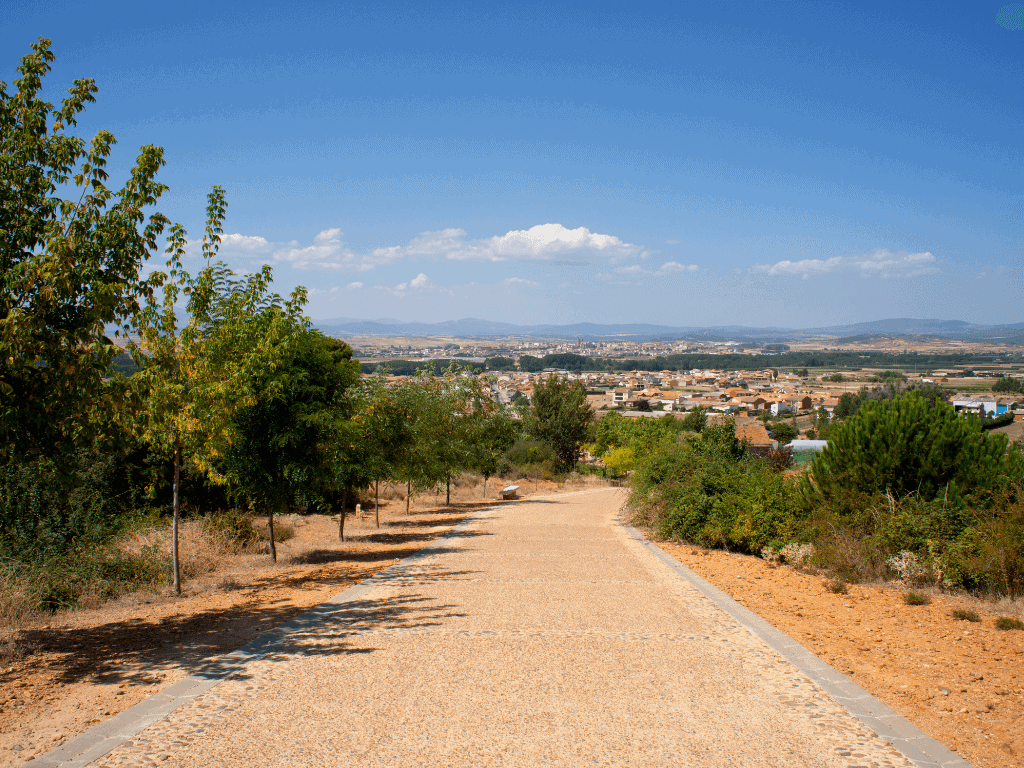Astorga to Santiago: A Perfect 14-Day Camino de Santiago Itinerary
Disclaimer: Links on this page may be affiliate links. If you make a purchase after clicking a link, I may receive a small compensation to help power my site.
Thinking about walking the Camino de Santiago from Astorga? In this post, we’ll will detail the different stages between Astorga and Santiago de Compostela, including distance, route description, where to stay, and other tips to help you plan your trip!
First things first, Astorga is a small city in the northwestern Castile and León region of Spain. Located on the popular Camino Frances route of the Camino de Santiago (the Way in English), many popular guidebooks recommend undertaking Astorga to Santiago in 10 days or “stages.” Of course, there are plenty of pilgrims that follow those stages to a T. If you are particularly fit or in a hurry, you may find 10 days do-able.
However, we found that 14 days was the perfect length of time to spend walking from Astorga. To explain, two weeks allow you to split some of the longer, more strenuous days (i.e. steep ascents and descents) into several stages. Plus, it gives the body time to adjust to walking long distances on the daily!
This 14 day itinerary on the Camino de Santiago from Astorga will tell you everything you need to know to walk from Astorga to Santiago de Compostela!
14 Day Astorga to Santiago de Compostela Itinerary
The following itinerary gives the suggested stages and recommended albergues (pilgrims’ hostels) for starting the Way in Astorga.
Stage 1: Astorga – Rabanal del Camino
12.31 mi / 19.81 km
After a good night’s sleep, you’ll be ready to head out early on your first day on the Camino Frances. For most of the day, wander along a series of flat, gravel paths. Since there isn’t much shade, take a break at the sidewalk cafes whenever you see them. At the end of the day, just when you’re about knackered, it’s time for the climb to Rabanal del Camino. Even though it’s not a steep incline, the terrain certainly changes to a hilly area as you head into town.
Brightly covered hammocks in hip gardens greet you as you ascend along the cobblestone. To visit the municipal albergue, turn left. If you continue up the hill, you’ll find the church where you can attend Pligrim’s Mass in the evening should you desire. Just to the left of the church is the lovely albergue donativo (donation), Refugio Gualcelmo. Here, you can pay what you are able with the suggested donation being a minimum of 5€.
The town has a small shop to buy fruit or snacks for the next day and several restaurants serving the pilgrim’s menu (a prix fixe meal costing around 10€), drinks, and small plates.
Recommended albergues: Refugio Gualcelmo (donativo), Albergue Nuestra Señora del Pilar (10€), Posada El Tesin
Stage 2: Rabanal de Camino – Acebo
10.35 mi/16.66 km
The highlight of this stage is beholding the famed iron cross, the Cruz de Ferro. In order to reach the iron cross early, head out before dawn. Located at the highest point on the Camino, it sits atop a 1.5-2 hr uphill hike. While reaching the iconic cross is a feat for those who started earlier, it’s no less meaningful to those who have just started. We suggest you use this time at the park to pray and reflect on your intentions for your journey.
Say goodbye to the iron cross for a glorious day meandering through a delightful and grassy mountainside. In summer, the purple and yellow wildflowers sing along both sides of the dirt path. Pass the last of the knight’s templar in Manjarín, a town consisting of one building and one resident, Tómas.
After a lovely morning, the trail suddenly turns steep and incredibly rocky. You have begun your descent. As you come upon the rooftops into Acebo, be sure to watch your step. Large rocks and loose gravel can easily turn slippery. Although many of the guidebooks say to continue on, reserve your energy. Instead, stay in Acebo. Indeed, you’ll be happy to recover your energy in order to tackle another challenging day (stage 3).
Recommended albergues: Albergue La Casa del Peregrino (17€; It has a pool!) | Check Booking.com
Stage 3: Acebo – Ponferrada
9.63 mi/15.5 km
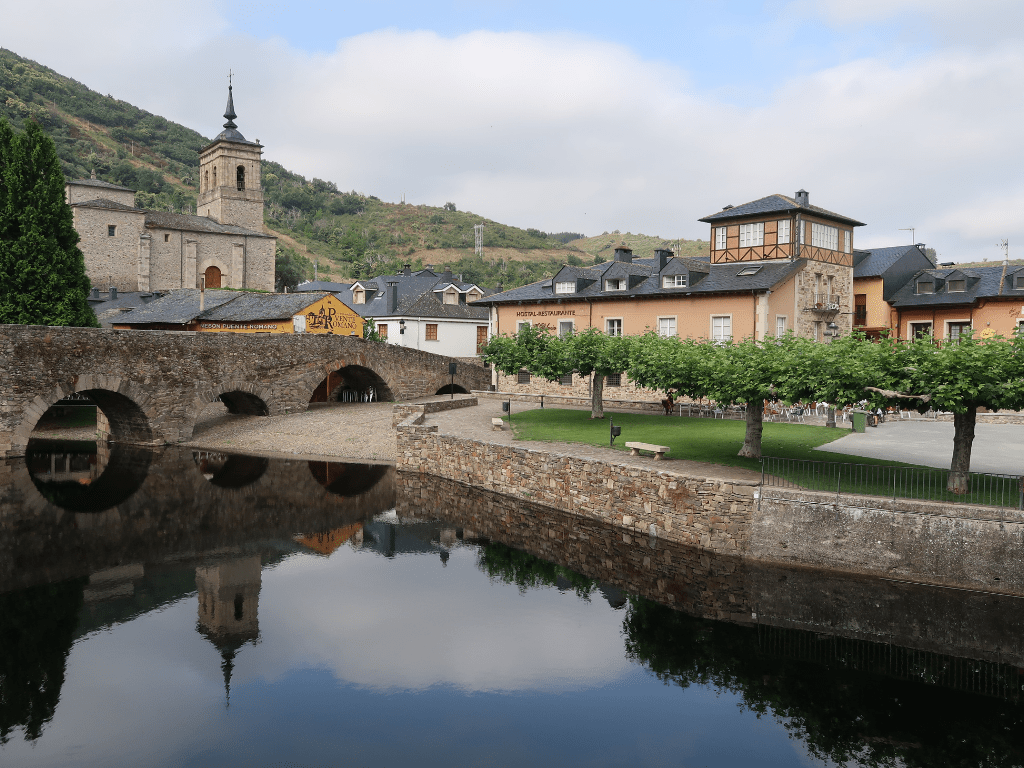
Continue downhill and out of the mountains. Today is a true descent; use your trekking poles to steady yourself as you climb on what appears to be a river bed of wide, smooth stones. Once the most difficult part of the day is done, a windy path will lead you to Molinaseca, a charming village at the foot of the mountain. Molinaseca is a popular tourist destination for Spaniards, so opening hours may be different from typical pilgrim hours when it comes to food. Find a café to savor lunch before soaking your feet in the damned off river. Let the chilling water soothe your feet and legs, which are surely swollen from your first few days on the path.
When you’re feeling rejuvenated, Ponferrada is just a few more miles/kilometers to go. Walk along the sidewalk of the main highway, or enter the medieval city via the countryside (follow the signs as to your preference).
Use the afternoon in Ponferrada to check out the castle (Yes, we said castle.), pick up items you need at the sporting goods store Decathlon, and shop for snacks at Mercadona (supermarket). If you can find an open physical therapy office, treat yourself to a well-deserved pilgrims sports massage later in the evening. Although it’s early to bed most nights on the Camino, spend some time tonight soaking up the atmosphere of the Plaza Ayuntamiento.
Recommended albergues: Albergue Guiana (15€; clean and modern) | Booking.com
Stage 4: Ponferrada – Cacabelos
9.8 mi/15.77 km
The way from Ponferrada to Cacabelos is all road walking with few café stops. As your feet pound the pavement, take the opportunity to muse at the everyday homes, shops, and various churches lining the way. If a church is open, you can stop for some shade, silence, and a stamp in your credencial.
Cacabelos is a tourist destination, so you’ll see families from Spain, not just pilgrims. Get there early, and you can take a wine tour, have a nice dinner, swim in the river, or soak your feet. It’s here that you’ll discover the most amazing vineyards and vino of the Bierzo wine region.
The municipal albergue in Cacabelos is interesting with only two people per room. It also cools off well due to the stone walls. The gorgeous Saint James Way hostel has smaller dorm rooms to share with just a few other pilgrims. It also offers private rooms, great A/C, and food served all day.
Recommended albergues: Albergue Municipal de Cacabelos (6€) | Saint James Way (20€) | Booking.com
Stage 5: Cacabelos – Trabadelo
11.39 mi/18.33 km
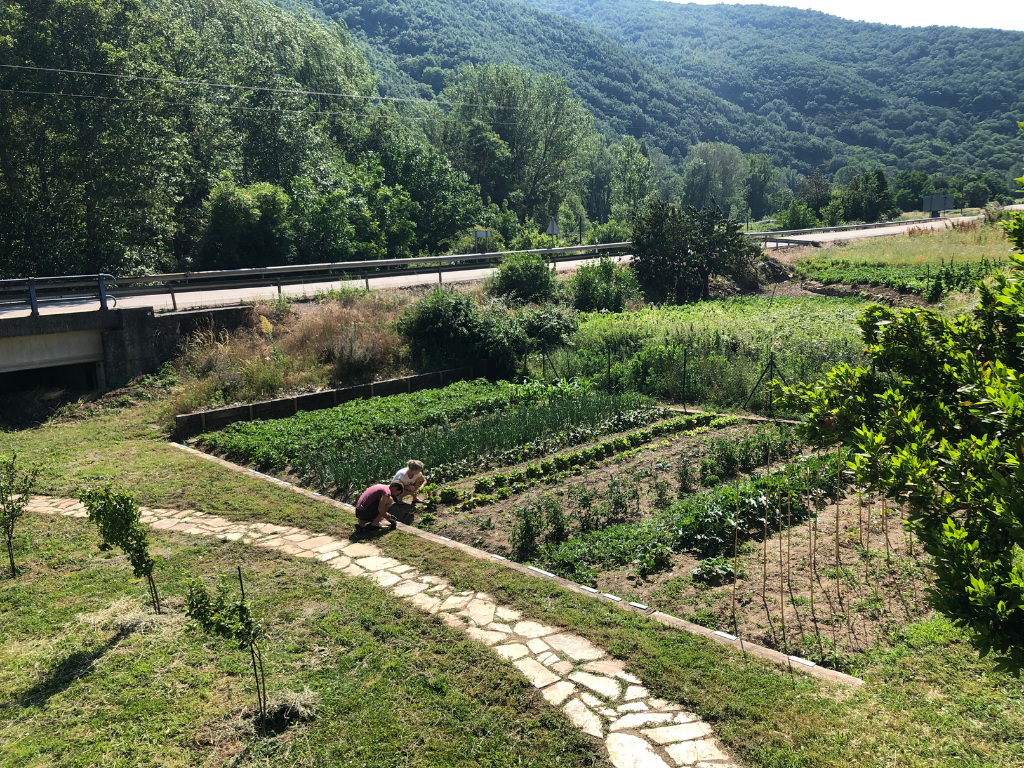
Staying the night in Cacabelos means you will sadly not sleep in the fairy tale village of Villafranca. Upon arrival, spend an hour milling around the town square, visiting the church, and taking photos. There are also plenty of outdoor cafés in which you can grab a coffee and tortilla de patata.
When leaving Villafranca, you walk at an incline along the side of a loud and busy freeway. Just when you’ve had enough, it’s time to stop in the small village of Trabadelo to visit Casa Susi.
Casa Susi is run by an Australian expat and her partner Fermín, who is from the Basque region of Spain. Opt for the communal dinner, and relax at the private river entrance while Susi prepares dinner from the garden. A night in the converted barn will surely be a highlight of your trip!
Recommended albergues: Casa Susi (donativo)
Stage 6: Trabadelo – O Cebreiro
11.4 mi/18.34 km

Even though it’s quite a climb, Trabadelo to O’Cebreiro is without a doubt the most breathtaking hike of the 14 day itinerary. After a quick breakfast, set out from Trabadelo towards the mountains. Ask a local which mountain you’re headed to, and you’ll find out you can’t actually see your destination as it’s shrouded in clouds most of the time.
At the foot of the mountain, the road splits clearly – hikers to the left and bikers to the right. Another option for this climb is to ride up on horseback, which you must arrange ahead of time (ask a hospitalero for help making the reservation). Because the horses ride up daily, pilgrims need to watch where they step to avoid a mess!
Once towards the top, slow down. These once in lifetime views deserve a pause. Next, continue to dance through the clouds and into lush Galicia. Stop to take a picture at the marker welcoming you to the region.
O’Cebrerio is a treat for the senses. You will feel as if you have entered another world, as stone buildings with thatched roofs pop up around you.
Note, O’Cebreiro is another popular starting point. You may want to consider reserving a room ahead on Booking.com or by phone. The municipal albergue is also a good option, but fills quickly. You can also stop one town before or after O’Cebreiro.
Recommended albergues: Albergue de peregrinos de O Cebreiro (8€) | Casa Navarro (36€; private room) | Booking.com
Stage 7: O Cebreiro – Tríacastela
14.19 mi/22.83 km
Today, walk a bit higher though an enchanting forest right out of the Lord of the Rings. After reaching the Alto do Poio pass, exit out of the mountains. As you descend out of the clouds, the experience can be described as nothing short of ethereal. Stop for photos of the panoramic view of the valley and surrounding towns. Although it’s downhill, the incline is not steep and the path is gravel. Thus, it’s a relatively easy trek.
Tríacastela is a town of 643 (2018) in Lugo, Galicia, Spain. In our experience of visiting in summer, this town tends to get busy. Consider booking the day before.
Recommended albergues: Albergue-Pensión Complexo Xacobeo (10€) | Albergue Atrio (35€; private room)
Stage 8: Tríacastela – Barbadelo
17.64 mi/28.39 km
The walk from Tríacastela into Sarria via San Xil varies from sidewalks, paved streets, and gravel paths. It is along here that you will encounter a steep and narrow path on which you should be careful not to slip and fall. You may also opt to walk a longer route through Samos.
Reaching Sarria, you will notice an uptick in pilgrims, especially in tour groups. The Camino also becomes more commercialized at this point with more options to stop for snacks and rest.
Since many pilgrims choose to start here, we suggest you continue just up the hill to Barbadelo. This will allow you to avoid some of the crowds that evening and in the morning.
Casa Barbadelo has a kitchen that’s open all day, gift shop, and pool. You can easily sit for a few hours and lazily enjoy a large sangria while reading, journaling, or chatting with other pilgrims.
Recommended albergues: Casa Barbadelo
Stage 9: Barbadelo – Portomarín
11.11 mi/ 17.88 km
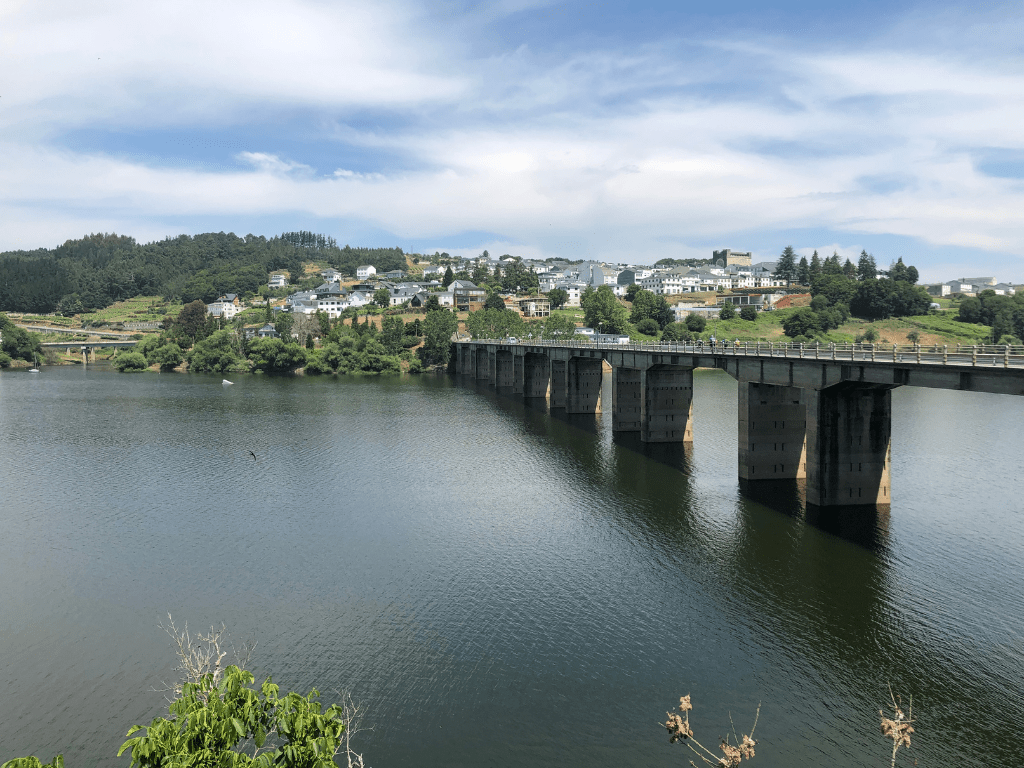
The walk from Barbadelo to Portomarín is easy and lined with several vendors selling painted shells and other trinkets. Today is also a special day because you will come across the 100 km distance marker. Stop for a photo, and savor the moment. You’re just 100 km from Santiago, and your journey is coming to an end.
After a few hours, you’ll come to the river. Overlooking it, an elevated town with light buildings awaits. To get to Portomarín, you must walk across a large bridge and head up some daunting stairs. When you arrive, you’ll be ready for a rest.
After many days in tiny towns, Portomarín feels like a lively city, although it’s still small. There, you can find a pharmacy, grocery, and several eating establishments..
Recommended albergues: Pons Minea (15€) Booking.com | Albergue Ferramenteiro (12€) | Booking.com
Stage 10: Portomarín – Portos
11.91 mi/19.16 km
From Portomarín, it’s another day of road walking mixed with jaunts in rural zones. Generally, it’s not too hilly after the first part of the day.
As many headed onwards, stop in Portos at A Paso de Formiga. This rustic hostel has outdoor chairs, a café, and refreshing soap.
Recommended albergues: A Paso do Formiga (12€) | Reserve on Booking.com
Stage 11: Portos – Melide
12.43 mi/20.01 km
Stage 11 is a leisurely walk into Melide. Here, the scenery is full of hórreos (elevated grain storage), bridges, and stone buildings. Melide is a larger town (pop. 7,824, 2011) with a grand boulevard running down the center. It’s a great place to stay and shop with many restaurants, grocery stores, and other shops.
Of course, no trip to Melide is complete without eating pulpo a la gallega, or steamed octopus. Instead of passing through, spend the night in Melide so that you can visit one of the many pulperías with other pilgrims. Share some tapas, a plate of octopus, and a few beers. It will be an evening well spent! Yum!
At this point, the excitement of reaching Santiago is palpable. There are many more pilgrims on the streets, in the cafés and bars, and at the hostels.
Recommended albergues: Albergue San Antón (15€; outdoor garden with bar to relax in for the evening) Booking.com | Pension San Anton ($41; good for private or small groups; has yard with pool) Booking.com
Stage 12: Melide – Arzúa
8.47 mi/13.63 km
After about 10 days, your body will probably need some rest. Take a shorter, hilly hop over to Arzúa. You will come in contact with the N-547 highway multiple times on this stretch, crossing under it several times. Just before town, it’s another hill climb.
Arzúa itself doesn’t have much to see, but it is famous for its cheese. It holds a cheese festival in March. It’s advisable to spend the rest of the day resting, doing laundry, or other chores.
Recommended albergues: Albergue Ultreia (10€) Booking.com | Albergue San Francisco (14€) Booking.com
Stage 13: Arzúa – O Pedrouzo
12.1mi/19.48 km
On your last day before heading to Santiago, pass through various forests, small towns, and meadows. If you haven’t noticed by now, you’ll certainly see your fair share of cows these last few days. Watch your step!
As you come into O Pedrouzo, you’ll be on a main roadway. Shops, albergues, and restaurants line the way. It’s here that you’ll eat your last pilgrim’s meal and sleep in your last albergue. Relish in it.
Recommended Albergues: Albergue de peregrinos de Arca – O Pino (8€) | Albergue Otero (12€)
Stage 14: O Pedrouzo – Santiago
11.91 mi/19.16 km
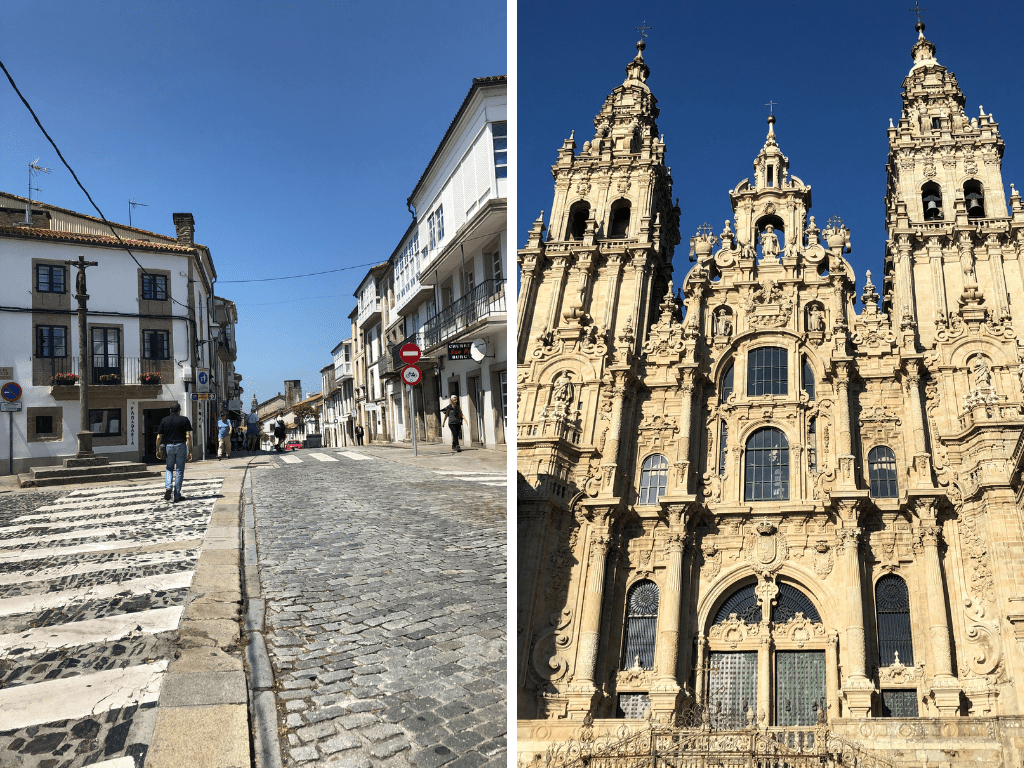
Savor your last day on the Camino de Santiago. Rise early, and head into Santiago. Most of the day is spent walking through hilly suburbs on roads and sidewalks. You’ll even pass by the airport! Get your first glimpse of the Cathedral of Santiago de Compostela from Monte de Gozo park.
After reaching Monte de Gozo, descend into Santiago. Cross the highway, and all of a sudden, you’re in the city. A colorful sign adorned with ribbons and old shoes will greet you. But, your journey isn’t over yet. The cathedral is about another walk along the sidewalk.
Follow the yellow arrows (which are a bit harder to spot now that you’re in the city) to the historical city center. Once you cross over to the old city center, you’re almost there. Pass through the alleyways and tourist shops until you reach the Plaza del Obradoiro in front of the Cathedral de Santiago de Compostela.
When you’re done celebrating in the Plaza del Obradoiro, pick up your compostela. The pilgrims’ reception office is down the street to your left if facing the church.
Recommended Albergues: Parador de Santiago – Hostal Reis Catolicos (247€; splurge) Booking.com | Casa Douro (60€) Booking.com
Wrap Up
The road from Astorga on the Camino de Santiago has its ups and downs — figuratively and literally. That being said, Astorga-Santiago is great starting point for those with about two to three weeks vacation time. You’re sure to learn about yourself, meet new friends, and make memories for a lifetime. We hope you found this Camino itinerary from Astorga to Santiago useful. Buen Camino!
Pin it!


